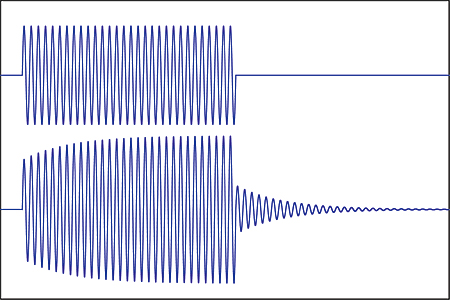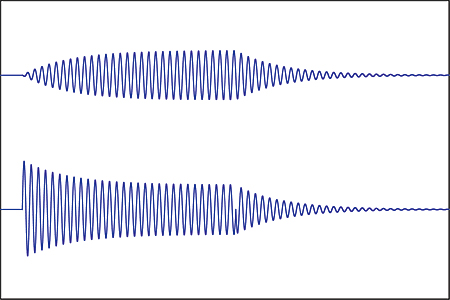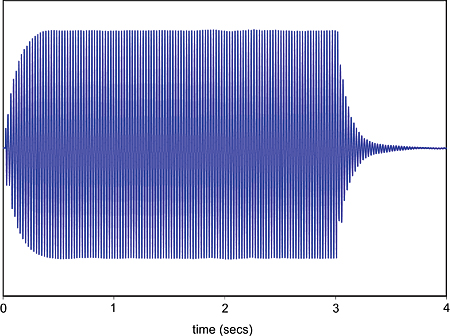| Columns Retired Columns & Blogs |
Very Cool! Thanks for sharing. It's really interesting to see what we can do a lot with sound waves nowadays. With the technology that we have right now, we can basically do everything. Nice post.
Pro Treadmill Review
In the time available to prepare this article, there was no way, of course, that I could devise a full-blown active absorption system of this type, or even simulate such a device. But a realistic aim was to try canceling the fundamental width mode in my room, as one example of what this approach might achieve that the current breed of room-correction systems does not.
Boom
Before I describe how I went about this and the results that accrued, let's look a little more closely at the effect of room modes using some computer simulations. Fig.4 shows two waveforms: the top a toneburst and, time-aligned below it, the same signal with the effect of a resonant mode added, the mode concerned having a center frequency equivalent to that of the toneburst. Because resonant systems first store and then release energy, the effect of the mode is initially to increase the amplitude of the toneburst progressively and then, after the toneburst ends, to add a decay tail. In both instances, the amplitude envelope follows an exponential curve.

Fig.4 Toneburst (upper trace), with the effect of a simulated room mode added (lower trace).
To counter these effects via the speaker that is reproducing the toneburst, we would have to feed it a signal that subtracts the effect of the resonance, thereby restoring the original signal. In the top trace of fig.5 is shown, on the same scales as fig.4, the waveform of the required correction signal (ie, the inverse of the modal response), with the waveform of the required speaker input/output below it. An interesting feature of the latter is the sudden polarity reversal at the end of the toneburst, which is shown zoomed along the time axis in fig.6. This sharp discontinuity, although unlikely to occur with music signals, suggests that the speaker must have a wide bandwidth to achieve accurate correction, so generating the necessary anti-resonance isn't an approach that would necessarily work well with a subwoofer rather than with a full-range speaker.

Fig.5 Modal contribution for fig.4 (upper trace), and the toneburst signal with modal correction applied (lower trace).
In practice, it is not usual to attempt complete cancellation of a mode, as illustrated in figs. 5 and 6. More normally, only partial cancellation will be applied, to shorten the mode's decay time and bring it into better correspondence with the desired low-frequency reverberation time for the room. This means that the mode will continue, albeit to a lesser extent, to exert the effects illustrated in fig.4.

Fig.6 Lower trace of fig.5 zoomed on the time axis to show more clearly the required polarity reversal that occurs when the toneburst ends.
If, instead of applying the modal correction via the main speaker, we apply it via an active absorber, then the correction waveform we need to generate is simply the inverse of the modal response; ie, the top waveform of fig.5. As this waveform lacks any sharp discontinuity, it can certainly be reproduced by a subwoofer. A very simple IIR digital filter, with just four coefficients, is all that is needed to create it, but first we have to know the three parameters that characterize the resonance: its center frequency, its relative amplitude, and its Q (quality factor, which is an alternative way of defining its half-power bandwidth). Fig.7 plots frequency-response curves for modes with a range of Qs from 1 to 32, showing how the resonant peak becomes narrower as Q increases. At the same time, the decay time of the mode increases, the decay to –60dB of the starting amplitude being given by the equation
T60=2.2Q/f
where f is the mode's center frequency. So a 40Hz mode of Q=20 will take 1.1 seconds to decay by 60dB.

Fig.7 Response shapes for resonant modes of different Q value, all with a center frequency of 100Hz.
In a fully fledged, automated room-correction system the center frequency, relative level, and Q of all the room modes can be determined from one measurement. For my experiment, I determined the center frequency of the width mode by calculation, and its relative level empirically by varying the volume control of an REL B2 subwoofer that I pressed into service as the active absorber. All that remained to determine was therefore the Q, which I went about measuring, as illustrated in fig.4, using a toneburst. Fig.8 shows the toneburst response of my listening room at 41Hz, measured with the driving speaker in one corner of the room and the microphone an inch from the opposite sidewall. An average of 14 tonebursts was taken to generate this composite. The decay response is shown on a linear amplitude scale in the top graph and on a logarithmic (decibel) amplitude scale in fig.9, zoomed to the mode's decay period (fig.9). Extrapolating the slope of the initial decay (red line), we find that the 60dB decay time of the room's width mode is 0.69s, equivalent to a Q of 12.9.

Fig.8 Averaged 41Hz toneburst response measured close to the sidewall of KH's listening room, on a linear amplitude scale.

Fig.9 Averaged 41Hz toneburst response measured close to the sidewall of KH's listening room, on decibel vertical scale showing the initial decay slope.
To set the appropriate output level for the subwoofer in its active absorber role, I authored a DVD-Audio disc with a train of these tonebursts in the left and right channels and the simulated response of the width mode in the center channel. The system was set up as normal, but with the subwoofer placed in one room corner, close to the right speaker, and fed from the DVD player's center channel. At a volume setting representing a typical listening level, I set the subwoofer polarity to negative and adjusted its gain—with a handheld volume control connected, via long phono leads, between the DVD player and sub—to achieve best cancellation of the width mode. I had hoped to use the measurement microphone for this, with its output fed to an oscilloscope for a real-time display of the toneburst response. But I struggled to achieve meaningful results this way and so resorted to standing close to the sidewall and adjusting the subwoofer volume for minimum level there, which indeed resulted in the maintenance of a more even level across the width of the room.
The next step was to determine which pieces of music to use for the listening tests, my selection being three tracks that I habitually turn to when bass quality is at issue: the opening double-bass solo of Brian Bromberg's "The Saga of Harrison Crabfeathers," from Wood (A440 Music 4001); Jennifer Warnes' "Somewhere, Somebody," from The Hunter (Private Music 261974); and a mono recording of direct-injected Rickenbacker bass guitar played by John Atkinson, which he sent me for "Wayward Down Deep," my article about bass phase correction published in the July 2006 Stereophile (Vol.29 No.7, p.57). To create the modal correction feed for the subwoofer these tracks were first converted to mono, the resonance processing applied, and the resulting WAV file once again placed in the center channel of a DVD-A, alongside each track's left and right channels. The DVD-A was then replayed at a similar volume setting to that used in the setup stage, and the sub's volume control used to fade the modal correction in and out. The speakers were B&W 805Ss—the same as used for the measurements shown in figs.1 and 2.
However much I'd like to recount a Damascene listening experience, the results were in reality quite subtle. The change was nothing like as obvious as what I'd heard in the bass phase-correction experiment, for instance, and I would have preferred to have had an exact, objectively determined setting for the subwoofer output. Still, I thought I could detect a subtle improvement in bass weight and clarity with all three tracks when the subwoofer was energized, which in every case made the overall sound a touch more convincing.
I am now sufficiently intrigued by the potential for using active absorption to apply more complete modal correction, decoupled from the main speakers, that I'm planning a properly optimized hardware implementation, initially using the SignalWizard DSP board (www.signalwizardsystems.com). Don't hold your breath, but I'll let you know how I get on. In the meantime, I hope someone in the industry with the appropriate skills will dust off that Nelson Pass patent, cross the essential idea with DSP and an automated setup process, and see where the offspring takes them. I have an inkling that the result will be well worth hearing.

Very Cool! Thanks for sharing. It's really interesting to see what we can do a lot with sound waves nowadays. With the technology that we have right now, we can basically do everything. Nice post.
Pro Treadmill Review

Спасибки , кто ищет тот всегда найдет!